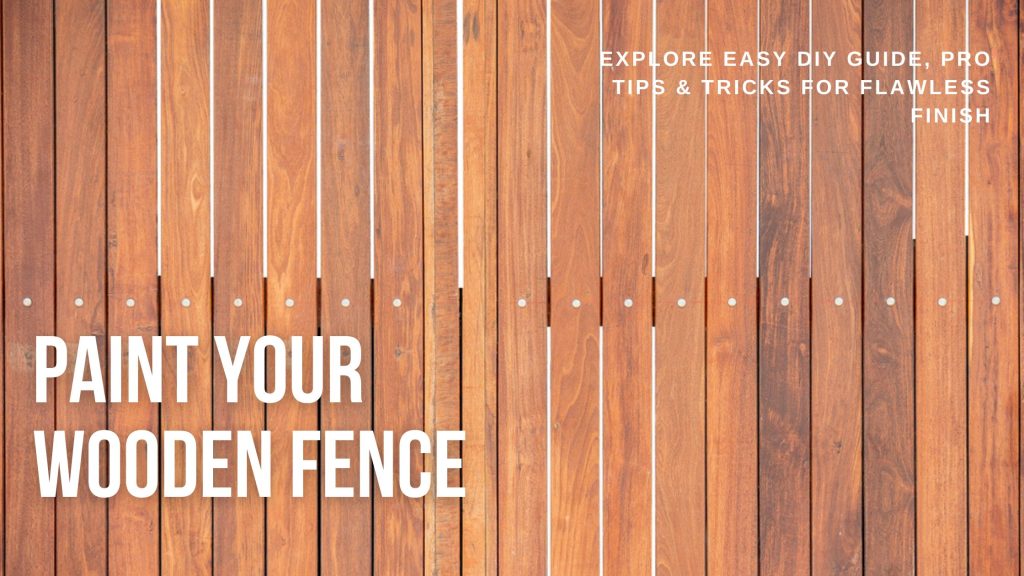Painting a Wooden Fence in WA? Explore Easy DIY Guide, Pro Tips & Tricks for Flawless Finish

Painting a wooden fence can give your backyard an instant facelift. Not only does a new coat of fence paint boost your home’s curb appeal, but it also shields the timber from harsh UV rays, moisture and pests. With the right wood fence paint and tools, you can tackle the project DIY-style and achieve professional-quality results.
Here’s your guide to know exactly how to paint a wood fence right, whether you do it yourself or hire a pro.
Before you start painting, make sure you have the right tools and materials on hand.
Essential Tools & Materials You’ll Need for Wood Fence Painting
Gather these supplies first. Proper tools make the job far easier and neater:
Item | Purpose |
Exterior Primer | Seals bare wood or old paint; improves adhesion and coverage. Always prime new or patched areas. |
Fence Paint | 100% acrylic exterior fence paints flex with wood and resist fading. |
Sandpaper / Scraper | Remove flaking paint and smooth rough spots. |
Paint Brushes | Use a synthetic, angled brush for edges, corners and details. |
Paint Roller + Extension | Cover large panels quickly. Attach a long extension pole so you can reach higher fence sections. |
Ladder or Scaffolding | Necessary for tall fences. Always work safely. |
Drop Cloths / Plastic Sheeting | Protect plants, patio and grass from drips. |
Painter’s Tape | Mask off adjacent walls, posts or trim to keep lines clean. |
Wood Filler / Putty | Patch nail holes, cracks or splits in the timber. |
Pressure Washer | For initial cleaning of the fence. |
Safety Gear | Safety glasses, mask (if sanding), gloves and sun protection. |
Once you’ve got your tools ready, it’s time to prepare your fence surface for painting.
Preparing Your Fence
Proper prep is crucial for a flawless result:
- Inspect and Repair – Walk the fence and inspect each panel. Look for rotten, cracked or wobbly boards, rusty nails/screws backing out, and peeling or moldy paint. Replace any rotten boards. Tighten or remove loose hardware. Sand away old flaking paint.
- Clear & Cover Area – Trim grass and clear debris around the fence. Remove pots or furniture. Lay down drop cloths or plastic to protect nearby plants and hard surfaces.
- Clean Thoroughly – Use a wood-safe detergent or fence cleaner to wash off dirt, mould and loose paint. A pressure washer (low-to-medium setting) is very effective. Rinse well. Don’t leave soap residue.
- Dry Completely – Let the wood air dry 1–2 days before painting. Even slightly damp fence wood will prevent paint from adhering properly.
- Sand Smooth – Lightly sand the surface to feather edges of old paint and rough areas. This gives paint a better grip. Wipe off dust after sanding.
- Prime If Needed – If you have bare wood or are changing from dark to light colour, apply a coat of exterior primer. It makes the bond between the wood and paint stronger. Plus, it adds life to the finish. You are able to load the primer into the paint sprayer or use your roller and brush. Primer seals the surface and evens out the texture. Let the primer dry fully (follow manufacturer’s drying time) before painting.
With prep done, choosing the right type of paint is the next step to ensure durability and a great look.
Choosing the Right Fence Paint
Use a paint formulated for exterior wood. For wood fence painting, water-based acrylic paint is top choice.
We recommend 100% acrylic exterior fence paint. It expands and contracts with timber, resists UV fading, and dries fast. Brands like Dulux or Wattyl make fence-specific paints mostly labeled “Exterior Fence Finish” or “UV-Resistant”. Remember: a quality fence paint costs more upfront, but saves money by lasting longer.
Now that you’ve chosen your paint, don’t overlook the impact of picking the perfect colour for your space.
Picking the Right Paint Colour for Fence
Your fence colour can transform the whole space.
- Neutral shades like greys, beige, earth tones blend with landscaping.
- Brighter or contrasting colours like black or white can make a statement. Black looks crisp and contemporary. While white brightens a yard (though white will show dirt more).
In Perth’s sun, lighter colours are more practical. We suggest light greys or beige-whites to keep fences cooler in summer. If your fence is natural timber, earthy greens and browns complement it well.
With colour and paint sorted, let’s walk through the actual steps to paint your fence like a pro.
How to Paint Your Fence | Step-by-Step Guide
Make sure your fence is clean, dry, and primed (if needed) before you begin. Choose a mild, dry day for painting so the paint dries evenly. Then follow these steps for a smooth, durable finish:
Step #1: Prepare Your Paint and Tools
- Stir the paint thoroughly in its can to ensure an even colour and consistency. Pour a manageable amount into a roller tray or the paint sprayer reservoir.
- Thin the paint if using a sprayer: Follow your sprayer’s instructions for thinning so the paint flows smoothly without clogging.
- Load your roller and brush: Dip the roller into the tray and roll it up and down to soak up paint. Use long, even strokes to apply paint when rolling. For edges, corners, and posts, use a wide, clean paint brush with smooth bristles. Holding the brush at a slight angle helps you get even coverage in tight spots.
- Protect the area: Remove or cover any nearby objects (plants, furniture, hardware) to prevent splatters. Apply painter’s tape along edges or trim you don’t want painted.
Step #2: Apply the First Coat
- Start at one end and work panel by panel. Roll paint onto each plank in the direction of the wood grain. Paint from the top of the panel downward to help catch drips on unpainted wood.
- Use the right tool for each part: Apply paint with a roller on the flat, broad sections of the fence. Then “cut in” along edges, rails, and posts with your brush. This combination (roller for big areas, brush for detail) ensures even coverage.
- Apply thin, even layers: Don’t overload your roller or brush. It’s better to make multiple light passes than to lay down one thick coat. Thin coats dry faster and reduce runs or drips.
Step #3: Let the First Coat Dry
- Allow full drying time before adding another coat. In warm, dry weather this may only take a few hours; in cool or humid conditions it could take up to a full day.
- Check that the paint is dry to the touch: Gently touch a hidden area to ensure it feels set. If paint is still tacky, give it more time.
Step #4: Apply Second (and Additional) Coats
- Apply a second coat just like the first. Once the first coat is dry, paint another full coat using the same roller-and-brush technique.
- Two coats for full coverage: Two coats are generally needed on new or bare wood. The second coat will deepen the color and add durability. If the original fence colour was very dark or if you are painting a metal fence, a third coat can help ensure no old colour shows through.
- Inspect and touch up: After the final coat dries, walk along the fence to look for any thin spots, drips, or missed areas. Touch up these spots by feathering paint in gently with a brush.
Step #5: Clean Up Your Work Area
- Remove tape and coverings: Before the paint fully cures, peel off any painter’s tape or protective sheeting so you don’t pull off cured paint.
- Clean your tools: Wash brushes and rollers with warm, soapy water if you used latex (water-based) paint. For oil-based paint, clean them with mineral spirits or the recommended solvent. Clean the paint sprayer components as directed by the manufacturer.
- Put away leftover paint and tools: Store any remaining paint in its can (sealed tightly) for future touch-ups. Rinse and dry all tools before storing them.
Pro Tips: Keep your brush and roller loaded and wet. Frequently reloading keeps the brush ends from drying out and dragging.
Want even more expert advice? Check out our 9 Tips for Fence Painting to avoid common mistakes and get a flawless finish.
When to Paint Your Fence in WA?
Timing your paint job right can make all the difference, especially in Perth’s sun.
Avoid painting in direct sun, rain or strong wind. Choose a dry, mild day, Paint early morning or late afternoon when the fence is cool. Check the forecast and skip any days with rain or high humidity (moisture prevents paint curing).
Perth’s rainy season is winter, so spring/summer (Oct–Mar) is usually best. But avoid the peak midday heat above 30°C. Also, remember WA has high UV: use a paint with UV stabilisers or add a clear UV-resistant sealant topcoat to guard against sun damage.
If you’d rather skip the hassle and ensure a professional result, we’re here to help.
Skip the Hassle | Let Final Touch Paint & Décor Give Your Fence a Flawless Finish
Give us a call and our experienced WA painters will handle everything; from prep to the final coat. We use premium timber fence paints suited for Western Australia.
Our fence painting experts work around your schedule and budget. So, say goodbye to drips and uneven coats; say hello to a beautiful, durable fence.
